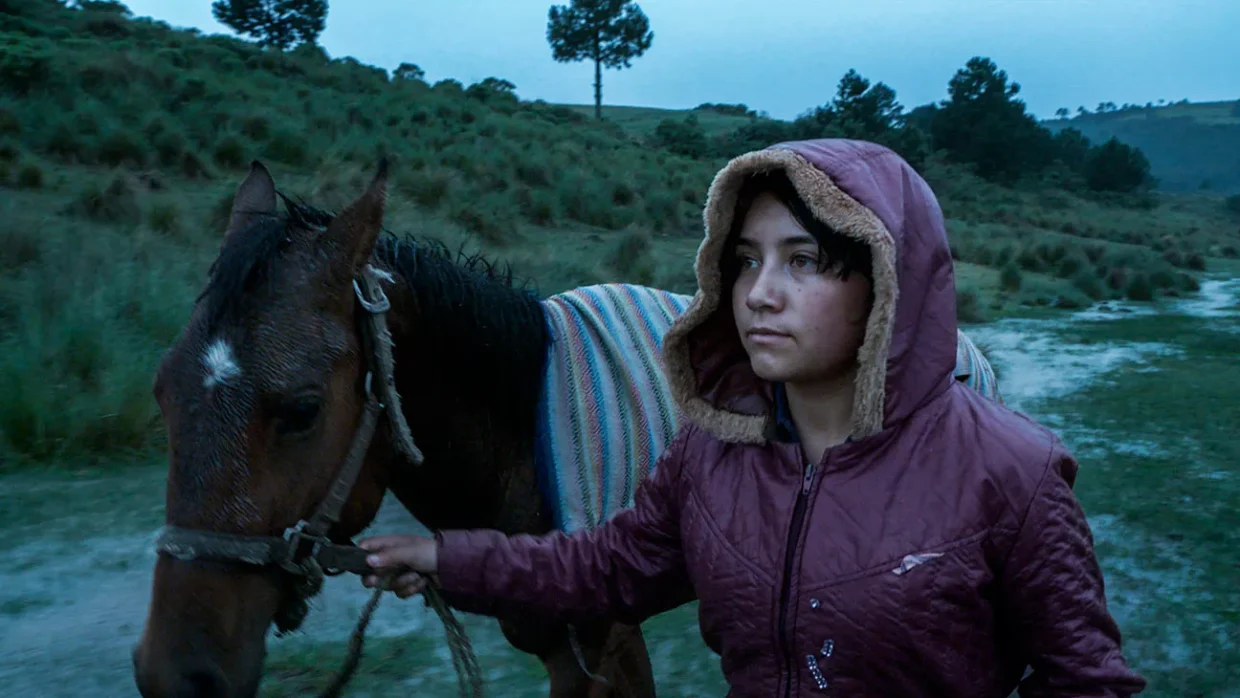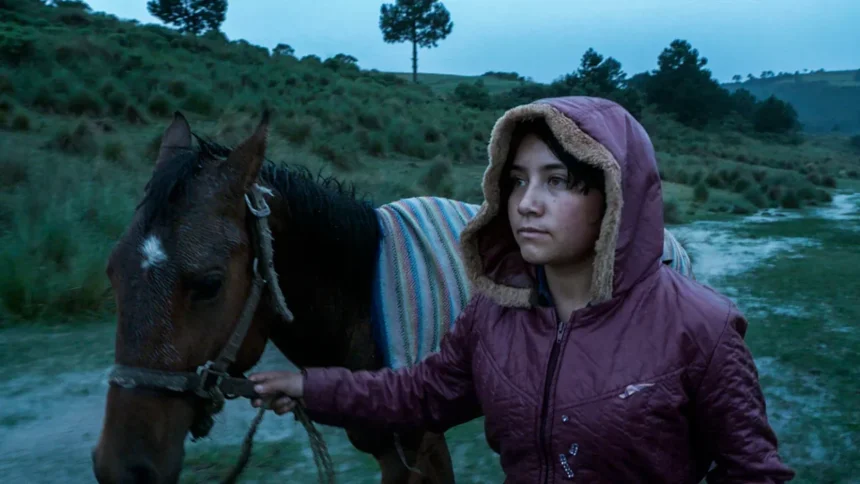 The Echo
The Echo Located within the Mexican municipality of Chignahuapan in the state of Puebla, the rural village of El Eco acts as a microcosm for various stages of life and the oft-small moments that herald them in filmmaker Tatiana Huezo’s documentary of the same name. The Salvadoran-Mexican filmmaker weaves together intimate scenes among three local families, exploring themes of gender, labor and generational shifts in attitude amid a sprawling and bucolic—yet unpredictably volatile—stretch of Mexico’s highlands.
The Echo is Huezo’s fifth feature, marking her return to nonfiction storytelling after helming her 2021 debut narrative film Prayers for the Stolen. With this transition, Huezo plays with style in the manner of a fiction film, a choice that imbues each shot with a cinematic sensibility that initially feels somewhat incongruous but is ultimately wildly absorbing. As Huezo documents her subjects—which include a strong-willed adolescent named Monste on the cusp of womanhood, her younger brother being primed with machismo ideals by their father, declining village matriarch Abuela Angeles, precocious youngster Luz Ma and her young mother Andréa—she eschews nonfiction conventions, capturing their daily lives with a gaze that is both familiar and fantastical, the latter quality undoubtedly aided by the impressive countryside. While there is bleakness within the film—death, disappearance, dispute—The Echo is an emotional balm compared to Huezo’s previous work, which vitally spotlights issues of human trafficking and femicide ignited by Mexico’s deep-seated national misogyny.
Huezo and I spoke ahead of The Echo screening as part of First Look, the annual festival presented by the Museum of the Moving Image that highlights innovative new films from around the globe. Our conversation covers the filmmaker’s oscillating interest between documentary and fiction narratives, her immersion into the rural community of El Eco and how she sought to capture the countryside.
This interview has been edited for clarity, with additional translation provided by Mexican-American filmmaker Jasmin Mara López.
Filmmaker: The Echo follows your 2021 narrative feature debut, Prayers for the Stolen. While you’ve come back to the documentary medium for this film, it appears crafted with a gaze that is staunchly cinematic—there are no talking head interviews, voiceover or extended use of verite conventions. How did crafting a fiction film influence your stylistic eye for this documentary project?
Huezo: The Echo is a project that was born before Prayers for the Stolen. After Tempestad, which is a very dark film that left me with a lot of pain in my heart, there was an enormous necessity to insert myself into a brighter world. As a result, I wanted to work with kids and make a movie about growing up in a rural environment, because those kids grow up very quickly. Anyway, the search for the town of El Eco began before Prayers for the Stolen. I eventually crossed paths with Nicolás Celis, the producer of Prayers, who offered me the opportunity to make it as my first fiction feature. So I left The Echo up in the air, but honestly, I feel like both films influenced each other. I already knew about the school in the town of El Eco, fell in love with those rural teachers and was submerged in that universe. In some ways, that sentiment also somewhat nourished Prayers for the Stolen, because it also features a sequence with a teacher in a rural school who closes one eye and puts up a finger to observe how one’s perspective changes.
When I finished Prayers for the Stolen—which was a huge production for me, featuring a crew of 100 people—I returned to The Echo. I had an enormous need to continue with this project. Let’s just say I really wanted to return to my original territory: to step into other places, be with people and look into their eyes. It’s something I enjoy a lot. But there was a lot of preparation that went into this movie, which included four years of forming a bond with the community and entering their daily lives as they cared for livestock and attended school and work, so that parents could trust me in their homes and with their children.
After Prayers for the Stolen, I had both fear and excitement to return to documentary filmmaking. With The Echo, I wanted to tell the story as if it were fiction through adopting that cinematic language. I wanted to make a documentary that could strongly connect with an audience. I am always thinking about how to shatter the stigma that documentaries are solely informative and boring. Documentary film is cinema and I love it. For me, a film is a sensory and emotional journey into another world, no matter how it’s transmitted, because it allows you to live in the skin of another human being.
To finish this answer, I want to note that The Echo was an opportunity to experiment with form. There are no interviews or voiceovers like in my previous documentaries. I’m eternally enamored with images—my background is in photography—and all of my projects are born from an image. I also understood that shooting over the course of a year, the weather and landscape itself would transform and affect the existence of these people.
Filmmaker: I want to know how you and cinematographer Ernesto Pardo decided where the camera, and the subjects, would be placed and framed during each scene? Many of these shots seem staged in a fashion that’s artful and not necessarily naturalistic.
Huezo: Many people tell me that this film is docu-fiction, and it’s not at all. I think it’s one of the purest documentaries I’ve made during my career—there’s not a single word that I impose on any of the subjects. The key to making this film was becoming close with these people, essentially becoming family with them. We could insert ourselves in their kitchens, which in Mexico we deem the most intimate family space, and that’s how we were able to capture such intimate moments. I don’t feel comfortable making cinema that gazes from afar. I like being so close that I can touch what’s in front of me and I can also be touched. Even the documentary device of talking head interviews is a form of intervention, and for this film I wanted to provoke certain conversations more naturally. For example, the scene where Andréa and Luz Ma’s father get into an argument is a strong moment, but I saw them fight like that many times. I knew how they argued and the disagreements that they regularly had—over money, over being exhausted. So one night after dinner, I said, “Okay, I’d like for you both to stay here at the table, I’m going to the other room. I am going to turn on my camera, and I’d like for you both to speak about something that you don’t agree upon in your everyday lives.” During the first 20 minutes, they didn’t say anything interesting. But I waited patiently for an hour and a half—meanwhile my camera’s SD card only lasted two hours—and finally that moment occurred and made its way into the final film.
An interesting conversation I constantly had with Ernesto was, “Where does the camera go?”, like during the scene where Luz Ma asks her mother, “Why did you get married so young?” I had told Luz Ma, while she was making cheese with her mother, that she could ask her any question she wanted. The camera was on Andréa, because we knew Luz Ma would ask her something and that a conversation would follow, but the girl asked such an incredible question, one that I would have never thought to ask Andréa myself.
Filmmaker: I’m also curious about how you decided to capture the natural landscape, and when you decided to shift your focus from your subjects to their surrounding environment during the shoot?
Huezo: The shoot lasted 18 months. For me, nature is a powerful narrative element and something I’ve been exploring for a long time. In Tempestad, for example, all of the landscape that we traverse somehow reflects the internal landscape of the characters. I think that a similar thing happens in The Echo. I wanted to make a film about growing up, which involves the passage of time, and the surrounding territory lent itself perfectly to that. These people depend on the earth; the connection that a rural kid has with the land is something that makes them unique from children that grow up in any other type of environment.
This film is also about cycles—through the animals, namely the sheep, these children understand life and death. Nature permeates their entire universe, particularly as it pertains to their relationship with animals. They kill a goat, but there’s no romanticism to it; it’s merely about surviving in the countryside. This world is marked by a lot of hardship, both economic and environmental. We also decided to film the animals as we would people—getting close to their eyes. Sound is also fundamental when it comes to humanizing these animals, because it also brings us closer to nature. These animal gestures, either sounds or bodily movement, convey a lot of force in the film. The breathing of a dog as he herds sheep—that’s what links us as viewers to animals and nature.
Over 18 months, there were about 11 trips to El Eco. I would go and film for two weeks, then spend two months away before returning. Every time that I went for those two weeks, I had a rigorous plan that deemed which days I would spend with which families. I wanted to enjoy myself on the shoot, but I started to have a lot of fear, thinking, “Is there a movie here? We’re filming quotidian life and nothing is happening.” After making some super-dramatic films, which all revolve around a traumatic event, I realized that this film is about the pleasure of observing life. I discovered that even in these minute details, there’s something also very grand happening.
I had an initial outline that began, “The movie starts in the rain.” I asked myself, what are the activities emblematic of rain? What is life like during this weather? What are my characters thinking about? We have a rebellious girl living with her mother—how do they relate to one another or not? How is this girl being taught to be a woman? How is her younger brother being taught to occupy the role of a man? The film definitely also talks about how we prepare children for these roles in adulthood. There’s also an amazing grandmother, another protagonist, and her granddaughter, Montse, who cares for her.
This was a film that required me to constantly insert myself. For example, the grandmother’s death was a crisis on all levels, including for myself and the production team. She was my friend and the first woman who opened her door to me in El Eco. I decided to shift my focus to the absence of the grandmother. I was always reacting and adapting to the events that unfolded for these subjects.
Filmmaker: Do you have any projects you’re currently working on? How will you navigate the space between documentary and narrative filmmaking in your future projects?
Huezo: I’m writing a fiction script right now. I don’t want to say what it’s about, but I’m very excited. It will be my next film, and I’m currently in the process of researching and writing. I really want to work with professional actors—I’m always looking for new and exciting ways to get out of my comfort zone. That’s something that thrills me about film, the infinite explorations available. While the film features actors, it will also have regular people appearing in it. This is a challenge right now, finding a hybridity. I’m also beginning to develop a documentary.
I feed on both paths, and I can go between one and the other without any difficulty. But for right now, all of my energy is going into this fiction project, which I will hopefully start shooting next year.






